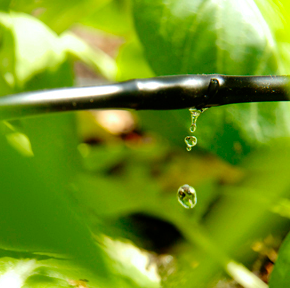This week’s scattered showers are not enough to bring relief to the sustained dry summer we’re having in Vermont. Not suprisingly, the degree to which farmers and their crops are affected depends on their access to water and their irrigation systems.
In general, Champlain Valley farmers may be faring better than their neighbors in the Pioneer Valley, Masssachusetts. While Vermont is experiencing abnormally dry weather, much of Massachusetts is facing severe drought conditions.
Moreover, Vermont farms that have invested in irrigation systems are reaping the benefits of this prolonged warm, sunny weather balanced by regular irrigation. With normal precipitation levels in Vermont at less than three quarters of their normal amounts, maintaining soil moisture is challenging but farms with healthy soils paired with an irrigation system are well positioned for this stretch of unusually dry weather.
In Burlington, Vermont, the Intervale Community Farm (ICF) started building its irrigation system 20 years ago.
We’re fortunate for being in the floodplain that we have abundant water supply with a main stem river and also some large high capacity wells in the floodplain – it has made us a much more resilient farm as we can contend with dry periods by using a mix of sprinkler and drip irrigation,” says Andy Jones, ICF’s farm manager.
Summers are hotter, the highs are higher, the existing soil moisture evaporates, and the plants transpire it more. We use drip irrigation where we have plants that don’t want water on the leaves or that are spaced far apart so we can get some real weed control benefits and some water efficiency benefits by not watering the whole area. For winter squash, melons, cucumbers, sweet potatoes, peppers, we use sprinklers and for almost everything else, drip irrigation.
However, drip lines can be problematic for organic farms, which are using mechanical cultivation as their main weed control tool. As Andy describes, “it can be pretty challenging to move drip out of the way If you want to go through there every week with a tractor. Every time you’re moving the drip line and when you go back and weed, you have to move the drip line and then when you want to irrigate again, the irrigation line is not in the right place.”
Andy describes that ICF’s sprinklers are spaced much farther apart so it’s easier to do routine weeding along with irrigating. There are also some cooling benefits from irrigation on a hot day with cool weather crops. And crops like greens and brassicas are hard to germinate in sandy soil without top water.
Andy points out the certain crops such as carrots, spinach, beets need water coming from above in order to germinate. Drip lines don’t typically spread the water wide for germination of these crops to occur.
Covering 20 acres of their production field, ICF’s main sprinkler and drip irrigation system is a mix of old and new equipment. Over the years, the farm’s investment in irrigation amounts to about $35,000.
I can’t imagine growing vegetables on sandy soil in a warm place like the Champlain Valley without irrigation – it’s absolutely critical to maintain crop quality and growth for a lot of our crops.”
Challenging conditions on Massachusetts Farms and Relief in Sight
Given this summer’s particularly dry conditions, irrigation can make the difference between a great harvest and poor harvest for many crops. Our neighbors in the Pioneer Valley, MA are taking a big hit. From crop loss to delaying second plantings, farmers without irrigation systems, are holding out for rain, trying to catch up with laying irrigation lines, and even recruiting more workers and volunteers for hand watering.
In response to a UMass Extension survey, 80% of MA farm respondents are losing at least 30% of a specific crop. This data will determine whether USDA’s Farm Service Agency (FSA) in Massachusetts can seek federal disaster assistance. In order to seek a disaster declaration and relief for Massachusetts’s farmers, the Farm Service Agency requires documentation of the extent of crop loss for each county.
While climate change in Northeast has meant a trend of warmer and wetter weather, this precipitation is occurring as more extreme episodic events and not necessarily when it’s needed, during the growing season. While five years ago we had record Lake levels and extreme flooding, for the past several summers, we’ve experience extended dry and hot periods in the Champlain Valley. Farms like the Intervale Community Farm that have invested in irrigation systems and planned their system according to crop and soil type are well positioned to have a bumper year.
Irrigation has been essential as otherwise we would have lost so many crops as irrigation allows us not only to keep things growing and bulking up, but other crops we can’t even germinate without irrigation so it’s the difference between a crop and no crop.
Drought assistance can be found by contacting your County’s FSA office, USDA’s drought program assistance. Information and technical assistance on developing a resilient farming strategy and building soil health in the face of climate change can be found at UVM Extension’s Center for Sustainable Strategy.


